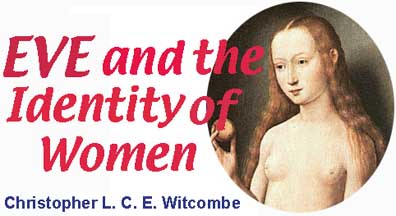|
||||
|---|---|---|---|---|

Female Figurine
|
4. Genesis & Patriarchy
The identity and character of Eve
in Genesis is not a divinely ordained fact but the misogynistic construction of patriarchal Hebrew writers.
The term "Hebrew" is generally used to describe the Old Testament patriarchs, beginning with Abraham and Isaac and ending with Moses, and to designate a period covering approximately 400 years dating from the first half of the second millennium BCE to the conquest in the 13th century BCE of Canaan (Palestine) that followed the exodus from Egypt during the reign of Ramesses II (1290-1224 BCE).
From the 13th century to the time of the Babylonian Captivity in the 6th century BCE, the same people are known as Israelites. After their return from Babylon, they are known as Jews.
Properly speaking, it is only after the conquest of Canaan in the 13th century that "Hebrews" are speaking Hebrew, which was a dialect of Canaanite, a Semitic language heavily influenced by Egyptian and spoken in the kingdoms of Israel, Judah, and Moab between 1500 and 500 BCE. For religious reasons, Hebrew is often treated as a distinct language.
The semi-nomadic Hebrew tribes led by Joshua that conquered Caanan in the 13th century lived in a pre-state society. When state formation did occur, around the middle of the 11th century BCE, it can be argued, based on other historical examples, that it involved a process which increasingly excluded women from public and religious activities and introduced a stricter regulation of female sexuality.
The story of Adam and Eve related in Genesis 2-3 was evidently composed around this same time and can be understood as playing a role in defining the new subordinate status of women. It should be noted, too, that it was during this same period that the Eastern Mediterranean as a whole was undergoing dramatic changes due to the impact of Indo-European invaders whose social and religious institutions were strongly patriarchal and patrilineal. One of the changes to occur was a significant downward shift in the status and role of women.
Although there can be no doubt that a patriarchal family structure predominates in the Biblical narrative, there is evidence in the Bible itself to indicate that previously there had been in some tribes a matrilineal and matrilocal family organization.
For example, the seven years Jacob spent in the service of Laban for each of his daughters, Rachel and Leah, would conform to matrilocal marriage practices (Genesis 29).
It has been suggested that a non-patriarchal social system in the background of the "matriarchs" Sarah and Rebecca could explain certain aspects of their behaviour. For example, in their abstinence from becoming pregnant, or remaining "barren," has been discerned a parallel in the traditional role among priestesses in their homeland of Mesopotamia.
It has also been pointed out that in the story of Jacob, each of his twelve "sons" is said to have married his own twin-sister which suggests a form of land-inheritance through the mother.
In addition, it has been argued that the usage of the phrase that a man must "leave his father and mother and cleave to his wife" (i.e. to move to his wife's family's residence) in Genesis 2:24 is also indicative of matrilocal arrangements.
This seems to have been a Canaanite (Palestinian) custom, as is suggested by the account of the marriage of Samson to the Philistine woman, Delilah (Judges 14). It is has been argued that this same custom accounts for Abraham sending his servant off to acquire a wife for his son Isaac from among his own patrilocal kinsmen of Harran rather than permitting him to marry a Canaanite woman and have Isaac adopted into her clan (Genesis 24).
Another hitherto overlooked instance suggestive of a matrilineal social structure wherein the woman is the head of the family can be found in the story of Adam and Eve where the serpent addresses not Adam, but Eve. The various reasons given for this (see Eve's Identity) tend to overlook the fact that the serpent completely ignores Adam.
It can also be pointed out that in the earlier period women could also serve as leaders, such as Deborah, and perform heroic deeds, and Jael who killed Sisera the leader of the Canaanites (Judges 4-5).
It may be argued that Genesis 2-3 both marks the historical shift to increasingly patriarchal social and religious institutions, and also served as a key document in support of the new patriarchal order by claiming it to be divinely ordained.
An earlier version of this essay appeared originally in Images of Women in Ancient Art
Copyright © (text only) 2000. Christopher L.C.E. Witcombe
|
|||


